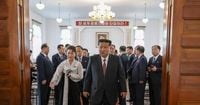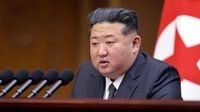North Korea is once again capturing the world’s attention as it marks the 80th anniversary of the ruling Workers’ Party of Korea (WPK) with a grand display of military might and international diplomacy. The tightly controlled capital of Pyongyang is hosting a rare confluence of foreign dignitaries, a spectacle of cutting-edge weaponry, and stern pronouncements from leader Kim Jong-un, all set against a backdrop of regional tension and shifting alliances.
On October 8, 2025, Kim Jong-un visited the Party Founding Museum in Pyongyang, accompanied by senior members of the Presidium of the Political Bureau of the Central Committee of the WPK and top officials from ministries and national institutions, as reported by Yonhap News Agency. The visit, a day ahead of the party’s milestone anniversary, was more than ceremonial. Kim used the occasion to issue a pointed warning to party officials, vowing to “eliminate” any movements that might undermine the authority of the ruling party. "We should continue to firmly consolidate strict order and sound discipline climate within the Party, while giving precedence to the process of finding out and eliminating in time all sorts of elements and acts that undermine the Party's leadership prestige," Kim declared, according to the Korean Central News Agency (KCNA).
Kim’s message was unambiguous: discipline must be enforced, and officials must avoid “evil practices such as ignorance, incompetence, irresponsibility, self-protection, formalism and expediency, as well as arbitrariness, high-handedness and abuse of power.” These words, delivered on the eve of the anniversary, underscored the regime’s intolerance for dissent or inefficiency, especially as the world’s eyes turned to Pyongyang for the celebrations.
But the anniversary was not just about internal party discipline. The event was meticulously choreographed to showcase North Korea’s growing diplomatic ties and military prowess. According to CNN, the celebrations included a massive military parade in Pyongyang, with tens of thousands of participants and a likely nighttime spectacle. Satellite imagery and South Korean military sources indicated weeks of preparation, with movements of vehicles and military equipment detected ahead of the parade.
Foreign delegations arrived in droves. China’s Premier Li Qiang, Russia’s former President Dmitry Medvedev (now deputy chairman of Russia’s Security Council), Vietnam’s Communist Party chief To Lam, and Laos President Thongloun Sisoulith were among the high-ranking guests. According to The Dong-A Ilbo, this marked the highest level of Chinese participation in a North Korean party anniversary since 2009, signaling Beijing’s renewed interest in supporting its isolated neighbor. Medvedev’s presence further highlighted the deepening ties between Pyongyang and Moscow, especially following the mutual defense pact signed last year and North Korea’s ongoing support for Russia’s war in Ukraine.
Vietnam’s To Lam began his three-day state visit on October 9, marking the first trip to Pyongyang by Vietnam’s top leader in nearly two decades, as reported by Reuters. Lam’s attendance, alongside other regional leaders, added weight to the international dimension of the festivities, which were clearly designed to project North Korea’s relevance and alliances on the global stage.
For many observers, the centerpiece of the anniversary was the military parade itself. North Korea has a long tradition of using such events to unveil its latest weapons, and this year was no exception. Analysts and military watchers speculated that the parade would feature the next-generation Hwasong-20 intercontinental ballistic missile (ICBM), the Hwasong-11 Ma hypersonic glide vehicle, and possibly even AI-powered systems or unmanned vehicles. Over the weekend, Kim attended an exhibition of advanced weaponry, including a short-range ballistic missile equipped with a hypersonic warhead, labeled “Hwasong-11Ma,” according to KCNA and CNN. The Hwasong-11 series, modeled after Russia’s Iskander missile, boasts a range of up to 800 kilometers, making it a credible threat to regional adversaries.
Hong Min, a senior research fellow at the Korea Institute for National Unification, noted, “The weapons shown in the parade will likely be on an unprecedented scale. Rather than focusing simply on large numbers, North Korea seem to be set to prioritize revealing systems that are impactful in capability.” Still, it remained uncertain whether the much-anticipated Hwasong-20 would make its debut, as it had not yet undergone a full launch test.
Security was, as always, paramount. Foreign journalists recalled the elaborate measures taken during previous anniversaries, with guests sequestered in the Yanggakdo Hotel, isolated on an island in the Taedong River to limit movement and ensure secrecy. When the parade finally began, the spectacle was as much about control as it was about celebration: columns of soldiers goose-stepped across Kim Il Sung Square, and the vast crowds moved in perfect unison, all under the watchful gaze of Kim and his foreign guests.
Yet the parade was not merely a show of strength for domestic consumption. As reported by CNN, Kim used the occasion to issue veiled threats toward the United States and South Korea, warning that “special assets” had been assigned to “major targets of our concern” and promising additional military measures in response to the US’s expanded presence in South Korea. “In direct proportion to the US military’s arms buildup in… (South Korea), our strategic concern about this region has also grown,” Kim said. Lim Eul-chul, a professor at Kyungnam University, interpreted these remarks as a warning that US bases and key facilities in South Korea could become targets for North Korean strikes, with advanced strategic weapons—including tactical nuclear arms, hypersonic missiles, and AI-based drones—potentially in play.
Despite the combative rhetoric, Kim also offered a rare olive branch. He expressed “fond memories” of former President Donald Trump and indicated a willingness to resume dialogue with Washington, provided the US dropped its insistence on North Korea’s denuclearization as a precondition. Trump, for his part, has signaled openness to another meeting, though the prospects remain uncertain. The Asia-Pacific Economic Cooperation (APEC) summit in South Korea later this month could provide a venue for renewed high-level contacts, though tensions remain high.
The gathering of North Korean, Chinese, and Russian leaders, with their military parade aimed at South Korea, the United States, and Japan, sent a clear message of solidarity and defiance. As The Dong-A Ilbo noted, the timing appears intended to signal an “anti-U.S. alliance” ahead of the APEC summit, where both President Trump and China’s Xi Jinping are expected to attend. Meanwhile, the US continues to press South Korea to bolster its defenses against both North Korean and Chinese threats, with calls for enhanced missile defense and electronic warfare capabilities.
As the 80th anniversary celebrations unfolded, North Korea demonstrated not only its enduring capacity for spectacle and control but also its determination to assert itself as a nuclear-armed power with friends in high places. The world, for now, is left watching—and waiting to see what comes next.

